On December 1, 2018, the greenhouse began its winter session. We had maybe up to 10 people involved from the Lehigh community seeding. Much of this seeding was done on a whim, without much consideration of transplanting to the main garden and where crops would go next. The goal of this greenhouse day was to create a living greenspace to be able to visit during the winter. Included seeds were, from right to left on the bench:
Morning glories, Peas, Onions (had sprouted in our kitchen and decided to give them a new life), Potatoes (had eyes growing on them), Carrots, Lettuce, Winter Spinach, Anise Hyssop, Swiss Chard, Tomatoes, Cabbage, Parsley, Cilantro, Eggplant, Beets
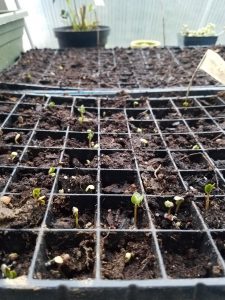
Not all of these plants ended up sprouting, sadly. We had trouble with the Anise Hyssop and some of the cabbage, as well as beets. Of those plants that broke through, they were helped through the cold by an electric space heater and monitoring a few times per week. Once the spring semester started, we wanted to put into better use the sunlit space we had.
Greenhouse Day 2/9 Goals
- Indoor Goals
- Weed morning glory, pea, and carrot beds (leaving beneficial “weeds”)
- Help morning glory and peas onto string trellis
- Transplant rest of plants
- Reorganize shelving and storage
- Outdoor Goals
- Get new dirt from dirt pile in garden
- Integrate finished compost dirt into hugelkultur mound
Greenhouse Day Accomplishments
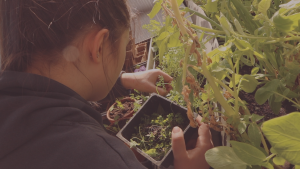
The weeding of the beds went well, except for the carrot bed. Too many carrots were planted in too shallow of a container, leading to their leaves all becoming entangled with bindweed. It was decided that the little carrot sprouts should be removed (and eaten for lunch, braised and as a bed for poached eggs) and the long planter be used for a better purpose.
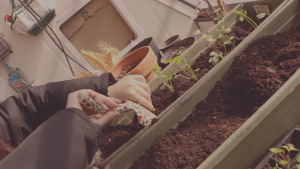
Repotting plants was exciting and good for their cramped root systems. They’d been in the plug flats for just about 2 months, and were ready to stretch their legs! Cilantro, Parsley, Tomatoes, and Lettuce have been planted in long planters to allow them to fill out for another few months, then be transplanted towards the spring equinox.
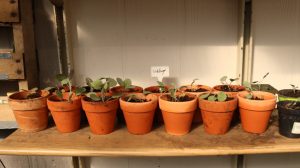
Hardier plants like Cabbages and Swiss Chard have been planted into individual pots to let the roots fill up each one, and they will be planted outside within the next few weeks once they survive this transplant and get settled. We will be looking for milk jugs to keep the small plants under outside so they have a miniature greenhouse.
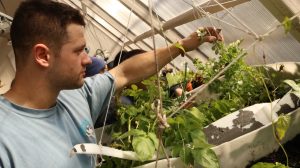
Climbing plants were detangled and strung up with the help of rocks and pottery shards to weigh the netting down. Peas have already begun blossoming, so now that they’ll be fruiting soon, we want them to have a good structure!
Future Greenhouse & Garden Plans
This spring, we’re already planning on planting potatoes and eggplants in the small bed next to the house. Lettuce, cabbages, and strawberries (from cuttings) will be planted in a space next to the eggplant bed which was overtaken last summer by Japanese Hops, a very spiky plant which was difficult to remove. We will also be planning on planting sunflowers, beans, and summer squash on top of the HugelKultur mound, as a modified Three Sisters. We’re not sure how well the HugulKultur mound will support these plants, but it’s our first season to try it out!
What You Can Do
Stop by the garden one day and just sit and appreciate the dormancy and peace winter has brought it. Take note of the “absence” of life, and use the space to clear your thoughts. Feel free to cross the street and enter the greenhouse, and see all the small, growing potentials of life waiting to populate the “barren” space you’ve just seen outside. See if you can imagine the garden at it’s peak this summer! Come back then to relax in the sun and see if your vision was right. Take care, breathe in, and love the soil. -H